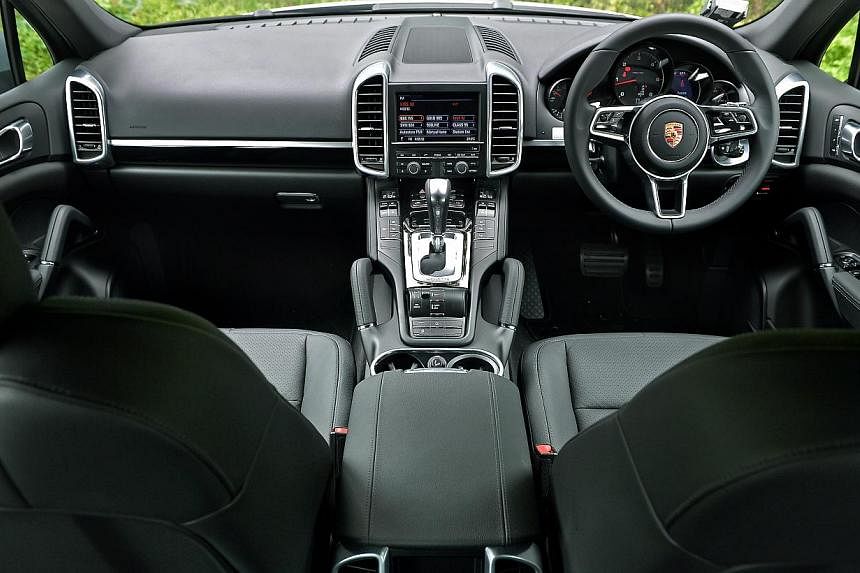As in most new Porsche models, cosmetic changes take a backseat to improvements made to driving dynamics in the latest Cayenne.
The sizeable SUV, built on the same platform as the Volkswagen Touareg and Audi Q7, manages to set itself further apart from its cousins.
The new model is perceptibly more driveable, with a nimbleness you do not expect of something so large but appreciate immediately when you encounter tight carpark ramps and small streets.
That is no mean feat, considering that its predecessor was already a rather accomplished urban carrier dressed in jungle fatigues. It held its own against the other well-sorted SUV, the BMW X5.
But when push came to shove, it was often a toss-up between the two. The new car puts that doubt to rest, as it is clearly the more agile and manoeuvrable one - that is, if you do not give any concession to the X5 being a seven-seater.
The third-generation Cayenne has similar dimensions as its forebear. There are minor but effective changes to its exterior, resulting in even less bulk visually and neater lines.
The rear - long the Cayenne's weakest stylistic angle - is vastly improved. Tail lights are now flatter and more sporty. The tailgate is more sculpted and extends southwards more - shaving down the profile of the rear bumper and lowering the loading height of the boot.
In short, the car is a little bit sleeker, which goes well with its sharper handling. It is still undoubtedly a big car, and it is obvious as you approach it or when you park it next to another vehicle.
But behind the wheel, the mass magically dissipates and you feel like you are piloting a much more compact machine. Its sweet and synaptic steering, relatively tight turning circle and tweaked suspension work together to convey ease and confidence.
The car's new drivetrain contributes to the positive experience in the latest range. The Cayenne S is especially endearing. Its new 3.6-litre bi-turbo V6, also found in the Porsche Macan, endows the car with a breeziness that is more common in a compact coupe.
It is significantly more efficient than the 4.8-litre V8 found in the previous Cayenne S. It puts out 420bhp and 550Nm - 20bhp and 50Nm more than its predecessor. This allows it to clock a sizzling 5.5-second century sprint (0.4 seconds quicker) and a top speed of 259kmh (1kmh faster).
Yet, its claimed fuel consumption of 9.8 litres/100km is 1 litre less than the last car. (Actual tested: 12.4 litres.)
The S is substantially smoother than the Diesel, which transmits an engine drone you can hear above the hi-fi, and which you can almost feel. Its electric parking brake is also stickier, requiring more engine pull to disengage. And its stop-start restarts with more abruptness and roughness. This takes it half a notch lower in refinement.
Its one impressive aspect is its efficiency. It boasts a fuel economy of 6.8 litres/100km, which is 0.4 litres better than the last Cayenne Diesel.
Its 2,967cc turbodiesel V6 produces 262bhp and 580Nm of torque - 17bhp and 30Nm more than before. Zero to 100kmh takes 7.3 seconds while top speed is 221kmh - a 0.3-second and 1kmh improvement.
Aiding both cars in their efficiency quest is a coasting function. A first for the Cayenne, it disengages the transmission when your foot is off the pedal, allowing the car's momentum to carry it forward.
If smoothness and refinement are important to you, the Cayenne S is the one to go for. It costs more, but it is worth it. You also get more features, such as a sunroof, reverse camera, navigation and motorised soft-closing doors.
Across the range, cabin architecture has been improved, with a cleaner layout of the centre console and more streamlined air-conditioning vents. The only thing that is a little out of place is the triple-stream windscreen washers that Audi favours. These are inferior in coverage to the misting type employed by premium cars. The only advantage of the stream style is that visibility is not compromised at all during operation.
Finally, prices have gone up, largely because of the tiered-ARF scheme. But that goes for the majority of new models here, not all of which can boast the meaningful enhancements found in the Cayenne.


